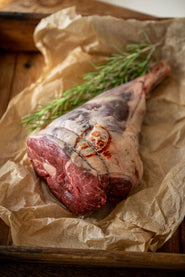For many hundreds of years, mutton was the main form of sheep meat eaten in the United Kingdom. Yet over the past 40 years, it has virtually disappeared from our kitchens - and we are in real danger of losing one of our iconic foods.
Mutton production has been entwined with the British landscape, our history, our wealth and our wellbeing since prehistoric times. The story of sheep and mutton is very much part of the story of the United Kingdom.
Mutton was the mainstay of British cuisine right up until the second world war when farmers were called up for duty and replaced in the field by less-skilled workers. It’s no surprise that badly reared native mutton treated brutishly in austere vats of boiling water, meant an entire generation had their palates tainted.
Post-war farming practices spawned our modern love affair with lamb while mutton, tragically, vanished from the nation's tables.
After the war came another food revolution. Vast imports hit our shelves in order to feed a baby boom nation. One of those products was New Zealand lamb. British homes were encouraged to ditch the traditional local meat of choice in favour of “The Meat of Sunshine” with persuasive ads such as “The Housewife looks to New Zealand Lamb, confident in the knowledge that while production increases, the traditional high quality of lamb will be rigidly maintained”.
The increase in cheaper imports put pressure on native farmers to speed up production of lamb, killing it younger and younger, to try and reduce their costs as well as keep up with the new trend for juvenile milky meat.
By this time it had already been ingrained in the retail psyche, as well as the housewives mantra, that consistency is key - something that our commonwealth cousins did exceptionally well.
Today the trend still remains with most modern lambs slaughtered very rarely beyond six months, yet without any doubt, the best sheep meat comes from pasture-fed animals who have lived a proper life.
Meat from older sheep has undeservedly had a bad press for decades. Two-year-old-plus sheep manage to keep their condition thanks to their hardiness and symbiotic relationship with the local landscape. There's a misconception that mutton are ‘old scraggy old ewes’. Actually a lot of care goes into nurturing a well-finished animal.

"Cull Yaw” is a term frequently employed in Cornwall to describe a cull ewe, which is a sheep no longer suitable for breeding. Like a fine bottle of wine, our mutton sheep simply get better with age. Time is the magic ingredient to produce a complexity of flavour that is simply not present in a younger animal.
Mutton to young/Spring lamb (or New Zealand lamb) is simply the equivalent of veal to our Red Ruby Beef. The key, of course, for mutton to reach its full potential is it that requires proper hanging time. Time for the tendons to relax through maturation, whilst the good bacteria get to work intensifying the flavour. Time is always the magic ingredient when it comes to mutton.
There is another clear satisfaction beyond the question of taste; being able to take an animal to its full potential in life feels like a distinctive gain in terms of welfare. Knowing that what is on our plates has truly been part of nature, nurturing the landscape in some of the most beautiful locations.
Forgotten no longer, it is our mission to put Mutton back on your table.






